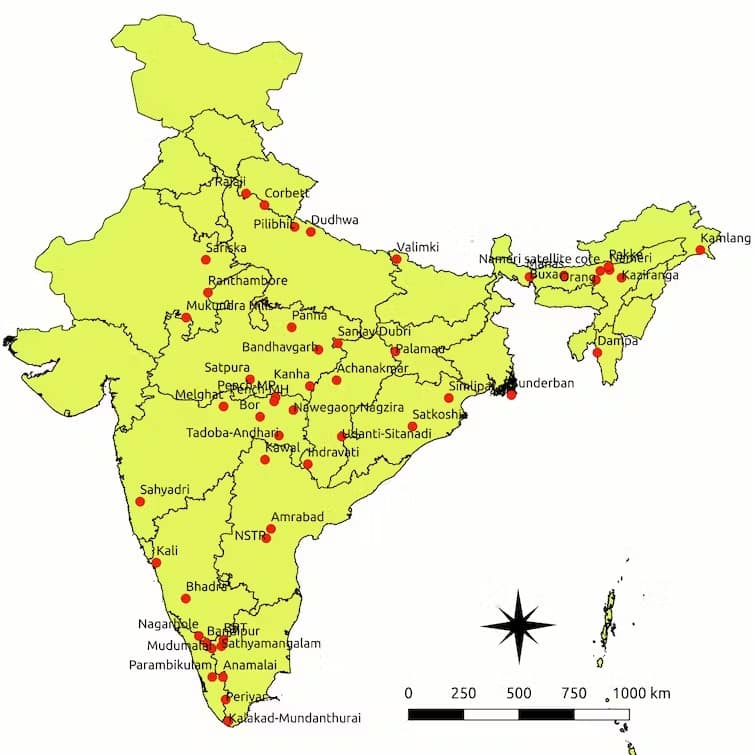India’s efforts in protecting its endangered tigers have resulted in avoiding over 1 million tonnes of carbon emissions by preventing deforestation, according to a study.
A study published in the journal Nature Ecology and Evolution has found a significant link between tiger protection and reduced carbon emissions, suggesting the potential for integration into carbon credit schemes.
India’s Tiger Protection Program
India is home to most of the planet’s wild tigers. However, deforestation has destroyed their natural habitat, leading to a drop in their population.
The number of tigers roaming the country’s forests declined to a mere 1,500 in 2006. However, India’s innovative tiger protection program, Project Tiger, has saved these big cats from extinction.
This year marks the project’s 50th anniversary, and last April, the Prime Minister announced that the tiger population in the country has risen above 3,000, representing over 70% of the wild tigers worldwide.
India’s Project Tiger began with only nine dedicated reserves five decades ago. However, the country now protects tigers across 54 reserves spread throughout the nation. The total protected area spans more than 75,000 square kilometers, equivalent to 2% of India’s total land area.
Tiger Reserves Spreading Across India

Apart from saving the tigers, the wildlife protection program also achieved another critical saving – carbon emissions.
Saving Tigers Saves Carbon Emissions
Researchers compared the rate of deforestation deforestation in the reserves to that in areas where tigers also reside but receive less protection.
Their study found that over ¾ of the forest loss happened outside the protected reserves. Moreover, between 2001 and 2020, 61,000+ hectares of forest were lost across 160+ different areas.
According to the lead author, Aakash Lamba, tigers are an umbrella species, meaning conserving them is also protecting their habitat. And forests are a natural carbon sink that sucks in CO2 more than they release.
Therefore, preventing deforestation also contributes to reducing CO2 emissions. The study found that approximately 6,000 hectares of forests within the tiger-protected areas were preserved between 2007 and 2020.
The substantial reduction in deforestation equates to a savings of over 1 million tonnes of carbon emissions. While this amount might seem small compared to India’s annual carbon footprint of approximately 2.7 billion tonnes, it still represents a significant achievement
The country has been snagging the carbon market spotlight with its various climate plans last year. It’s hastening efforts in transitioning to clean energy and reach net zero emissions by 2070.
Yet, the emissions avoided are substantial when monetized through carbon offset credits.
The authors suggested that the third-largest emitter could have earned more than $6 million from carbon credit sales had the project qualified for such crediting. They also estimated that the project helped the country avoid as much as $92 million in other ecosystem service costs.
Highlighting the carbon emissions savings and cost benefits of protecting tigers, the authors noted that “biodiversity conservation and climate change mitigation are intimately linked“.
In another study, protecting other wild animals can help capture over 6 billion tonnes of CO2 each year.
However, India’s Project Tiger does not qualify for generating carbon credits as it does not meet the additionality criterion. The 1 million carbon emissions savings took place on already protected areas.
Closing the Funding Gap with Carbon Credits
However, the authors asserted that insufficient funding for biodiversity conservation projects like these reduces their impact.
Their findings suggest that Project Tiger could be a game changer for protecting wildlife and biodiversity as it can be funded through carbon credit schemes.
They specifically stated that:
“Revenues from the trade of fungible carbon offsets, which represent standardized and internationally tradable reductions in emissions, arising from the recognition of the climate change mitigation benefits associated with biodiversity conservation can serve as a means of closing this funding gap.”
The financial savings from avoided carbon emissions account for about a quarter of India’s annual expenses on tiger protection. The country’s budget for the program in 2021 was almost $27 million.
Modifying the current crediting system could benefit not only tiger and wildlife protection in India but also in other regions.
However, the authors noted that incorporating tiger protection into carbon credit markets necessitates thorough consideration of local communities. Their participation is “crucial in equitable and effective conservation”.

